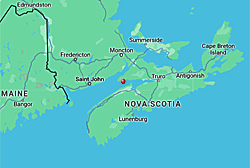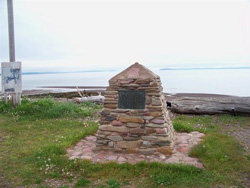










Spencer's Island is a rural community in Cumberland County, Nova Scotia, located at the western end of Greville Bay on the Bay of Fundy. The community is named after a small island of the same name located offshore from nearby Cape Spencer. The name is believed to come from Lord Spencer, a British statesman at the time the community was settled.
It became became an important shipbuilding centre during the latter days of the Age of Sail. The first large vessel from its shipyards was The Amazon built in 1861 and later to become famous when it was renamed the Mary Celeste.

The keel of The Amazon was laid in late 1860 at the shipyard of Joshua Dewis in the village of Spencer's Island, on the shores of the Bay of Fundy in Nova Scotia. The ship was constructed of locally felled timber, with two masts, and was rigged as a brigantine; she was carvel-built, the hull planking flush rather than overlapping.
For her maiden voyage in June 1861, Amazon sailed to Five Islands, Nova Scotia to take on a cargo of timber for passage across the Atlantic to London. After supervising the ship's loading, Captain McLellan fell ill; his condition worsened. The Amazon returned to Spencer's Island where McLellan died on June 19. John Nutting Parker took over as captain, and resumed the voyage to London, in the course of which Amazon encountered further misadventures. She collided with fishing equipment in the narrows off Eastport, Maine, and after leaving London ran into and sank a brig in the English Channel.
Parker remained in command for two years, during which Amazon worked mainly in the West Indies trade. She crossed the Atlantic to France in November 1861, and in Marseille was the subject of a painting, possibly by Honoré de Pellegrin, a well-known maritime artist of the Marseilles School. In 1863, Parker was succeeded by William Thompson, who remained in command until 1867. These were uneventful years; Amazon's mate later recalled that, "We went to the West Indies, England and the Mediterranean, what we call the foreign trade. Not a thing unusual happened." In October 1867, at Cape Breton Island, Amazon was driven ashore in a storm, and was so badly damaged that her owners abandoned her as a wreck. On October 15, she was acquired as a derelict by Alexander McBean, of Glace Bay, Nova Scotia.

The plaque and Cairn for the Mary Celeste was unveiled on 7th. August 1963. It was erected by the Nova Scotia Historical Society. Locals Steven McLellan and Robert Hughes were involved in the movement to get the monument erected.
Within a month, McBean sold the wreck to a local businessman, who in November 1868, sold it to Richard W. Haines, an American mariner from New York. Haines paid US$1,750 for the wreck, and then spent $8,825 restoring it. He made himself her captain, and, in December 1868, registered her with the Collector of the Port of New York as an American vessel, under a new name, Mary Celeste.
In October 1869, the ship was seized by Haines's creditors, and sold to a New York consortium headed by James H. Winchester. During the next three years, the composition of this consortium changed several times, although Winchester retained at least a half-share throughout. No record of Mary Celeste's trading activities during this period have been found.
Early in 1872, the ship underwent a major refit, costing $10,000, which enlarged her considerably. Her length was increased to 103 feet (31 m), her breadth to 25.7 feet (7.8 m) and her depth to 16.2 feet (4.9 m). Among the structural changes, a second deck was added; an inspector's report refers to extensions to the poop deck, new transoms and the replacement of many timbers. The work increased the ship's tonnage to 282.28. On October 29, 1872, the consortium was made up of Winchester with six shares and two minor investors with one share apiece, the remaining four of twelve shares being held by the ship's new captain, Benjamin Spooner Briggs.